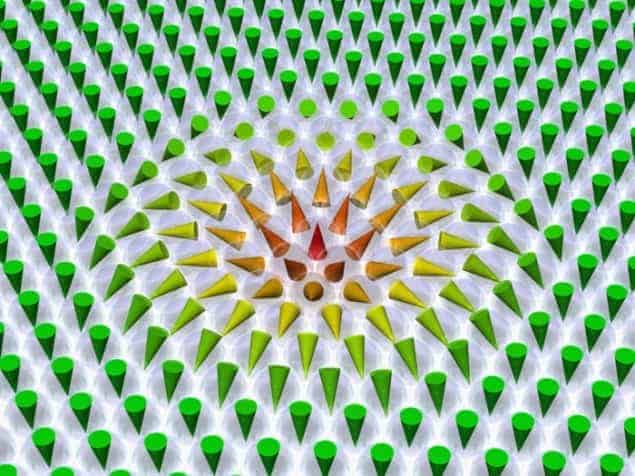
Researchers in Germany have succeeded in controlling tiny magnetic-spin patterns known as “skyrmions” for the first time. The result could be important for future high-density data-storage technologies and nanodigital electronic devices with improved data-transfer speeds and processing power.
Skyrmions are small magnetic vortices that occur in many materials, including manganese–silicide thin films (in which they were first discovered) and cobalt–iron–silicon. In the new work, the researchers studied a palladium–iron bilayer on an irridium-crystal surface. The tiny vortices can be imagined as 2D knots in which the magnetic moments rotate about 360° within a plane (see figure).
Skyrmions could form the basis of future hard-disk technologies. Today’s disks use magnetic domains (in which all of the magnetic spins are aligned in the same direction) to store information, but there are fundamental limits to the size such domains can be made. It might be possible to make skyrmions that are much smaller and that could therefore be used to create storage devices with much higher densities. What is more, flipping all of the spins in conventional domains – to switch a device’s memory state from 1 to 0, for example – requires considerable power and can be slow; skyrmions require fewer spin flips to switch. In addition, the final spin state is not easily disrupted – making these skyrmion structures more stable than conventional magnetic domains.
Creating and annihilating single skyrmions
Before skyrmions can be exploited in hard drives, however, scientists need to figure out a way to control them – something that has proved difficult to date. A team of researchers at the University of Hamburg, led by Kirsten von Bergmann, André Kubetzka and Roland Wiesendanger, has now shown that it is possible to create and annihilate single magnetic skyrmions using a spin-polarized current – one in which spin is mostly aligned in one direction – from a scanning tunnelling microscope (STM) tip, albeit at ultralow temperatures of 4.2 K. According to the researchers, the skyrmions switch from one state to another thanks to spin-transfer torques, and one state (skyrmions present) can be favoured over the other (skyrmions absent).
“To write or delete a skyrmion we position our STM tip at a particular spot on the sample and inject a spin-polarized tunnel-current pulse into it,” explains Von Bergmann. “While at low currents and voltages the sample magnetization is stable, at higher currents and voltages the magnetic state starts to switch between a skyrmion and a simple parallel alignment of magnetic moments,” she told physicsworld.com. “In this situation, the current direction can determine which of the states is favoured over the other – a clear indication that spin-transfer torque is involved in the switching process.”
IT applications
Being able to write and delete skyrmions in this way means that such spin textures can now be exploited in information technology. “In particular, the possibility of using layered thin films in this way, as is the case in conventional IT-device technology, could lead to a big step forward towards applications,” adds Von Bergmann.
The Hamburg team is now busy trying to understand the switching mechanism in more detail and finding out exactly how the spin-polarized current couples to the magnetization. “This will help us to optimize the process of writing and deleting skyrmions,” says Von Bergmann. “We will also be investigating other thin-film materials in an effort to unearth systems that show such skyrmion switching at room temperature.”
Skyrmions are named after the UK particle physicist Tony Skyrme, who in 1962 found that they could explain how subatomic particles such as neutrons and protons exist as discrete entities emerging from a continuous nuclear field.
The results are published in Science.



